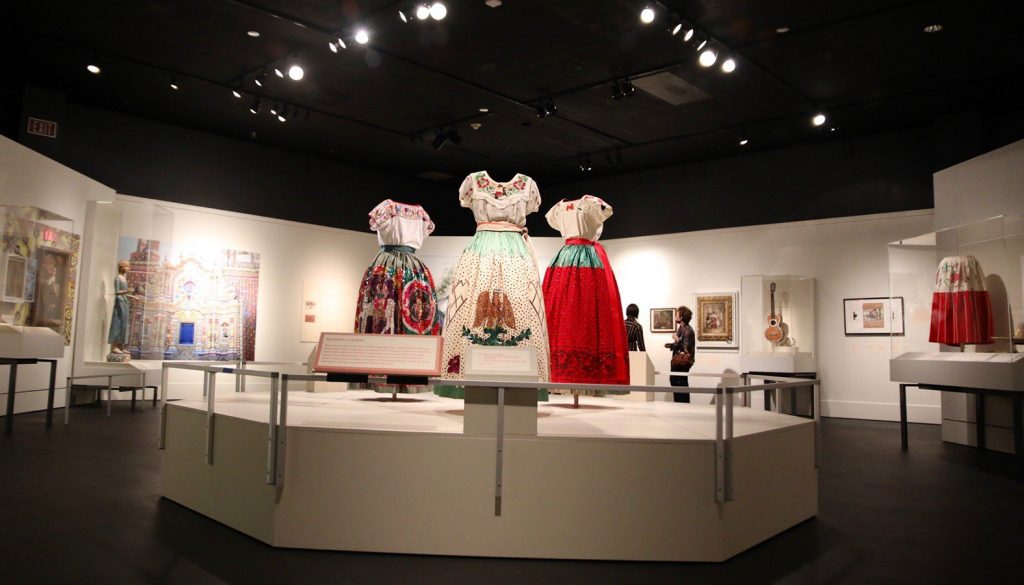Advent is upon us — a wondrous liturgical season and, to many of us, the most magical time of the year.
Those of us who love Advent because of the liturgy, the crèches, the sacred music, the O antiphons, and the expectant hush as we await the birth of a child must nonetheless hear an incessant chorus of grumbling against the commercialization of Christmas. If the commercialization troubles you, don’t participate in it! I certainly don’t.
In fact, Advent is a penitential season, and to underscore the fact we’re encouraged to mingle this time of year with all manner of people: friends, family, visitors. So why not combine penance and the desire to enlarge our hearts with a little field trip?
Why not take your crew, for example, to the Autry Museum in Griffith Park for an exhibit (ending Jan. 8), called “Dress Codes.”
What do we wear, and why? The exhibit encourages us to ponder. What does our clothing mean to us? What’s the difference, if any, between fashion and style?
“Dress Codes” unpacks six articles of clothing that are iconic to Western style: the blue jean, the plaid shirt, the fringed jacket, the China Poblana dress, the aloha shirt and the cowboy boot. Curator Carolyn Brucken provides an overview of the history of each item, and shows how, through the various ethnicities, cultures, and demographics of Southern California, they’ve evolved into both everyday wear and street fashion and spread throughout the world.
Colorful, inviting, and educational without being stuffy, the exhibit is a feast for the eyes. Vintage articles of clothing, many drawn from the Autry’s collection, are combined with photographs, text, video, art and montage.
In the 18th and early 19th centuries, denim was produced by slave and child labor: today, who knew, blue jeans have a reputation “of being one of the worst environmental offenders.”
Still, having evolved from the working-class gear of miners, railroad men, and wagon drivers, to part of the cowboy “lifestyle,” to sturdy women’s wear, to haute couture runway, they’re a multibillion dollar industry, worn around the world.
As Yves St. Laurent said, “I wish I had invented blue jeans. They have expression, modesty, sex appeal, simplicity — all I hope for in my clothes.” And, depending on where you shop, you can still buy a pair of Levi 501s for less than 40 bucks.
Wool plaid shirts also enjoy a long history. Though the shirt didn’t originate in the American West — Hopis wove plaid blankets; Scottish clans marked their identities through distinctive tartans — it’s “become variously the uniform of Western workers, California surfers, lowriders, musicians, and many others.”
Pendleton Woolen Mills in Oregon began with plaid blankets in 1895, moved on in 1924 to men’s wool shirts, and by the 1930s had made a name for itself with its beautiful and sturdy weave and rich colors. Ranchers and cowboys were early customers, and in time everyone from country western stars, to those surfers and lowriders, to longshoremen and dock workers have made the shirts their own. “You make your lifestyle around what you’ve got,” says San Pedro musician Mike Watt.
Fringe has a long history as part of Native American clothing and to this day is part of the “swing and sway” of Native song, dance, and community. Over the years it’s also been appropriated by trappers and hunters, Wild West showmen, hippies and the fashion industry. Some killer suede jackets, many with elaborate beading and needlework, are on display.
Aloha fashion lies at the intersection of island history and family tradition. Its long trajectory touches upon plantation labor, U.S. military presence during World War I and World War II presence in Hawaii, and the Western entrepreneurship of companies such as Cole of California and Catalina Sportswear that, starting in the 1940s, brought colorful Hawaiian-infused fashion to the mainland. For many Hawaiian families, an aloha shirt in a particularly fine pattern, fabric, or weave has a story attached to it and will be lovingly passed down from one generation to the next.
China (“female servant”) Poblana (of Puebla) is a style of dress, still worn today, whose somewhat murky origins are a mixture of legend and Mexico’s indigenous and colonial histories. Its elements include a hand-embroidered, often off-the-shoulder blouse; a full skirt adorned with beadwork, embroidery, or sequins; a striped or fringed belt; and the rebozo: a long, fringed shawl.
Granted, Jesus said: “Therefore I tell you, do not be anxious about your life. … Is not life more than food and the body more than clothing?” (Matthew 6:25).
Life is more than clothing — but “Dress Codes” is a glorious celebration of the fact that clothing is also part of our history, communities, and daily lives.
And let’s not forget the garment that trumps even the coolest jeans, pair of cowboy boots, or aloha shirt.
That would be the swaddling clothes in which Mary wrapped the newborn Jesus before laying him gently in the manger.

